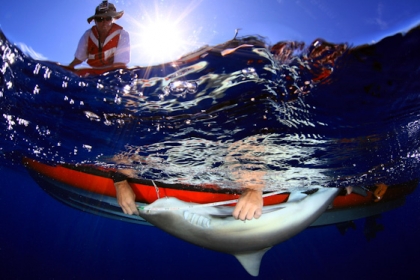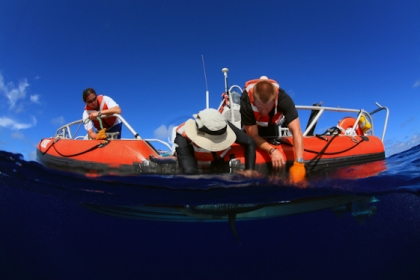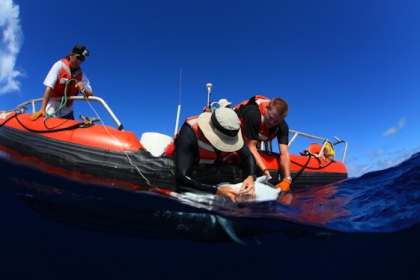Day two at Pearl and Hermes Atoll marked the northernmost point of this expedition and was the first opportunity to catch and tag some of Papahanaumokuakea Monument’s charismatic reef predators. The day was a mix of bottom-set long-line deployments, deep hand lining, and surface trolling with the aim of tagging Ulua (Giant Trevally) and Galapagos Sharks. Our surface trolling attempts proved ineffective at capturing our target species, so after hauling the long-line and deploying 3 pressure-sensitive ultrasonic transmitters in Galapagos sharks, we focused our efforts on hand lining. Our luck changed immediately as our first hand line brought up an Ulua, with more Ulua & Galapagos following from the deep reef ledge we had been setting on all day. Using a second hand line to maximize catch rates, it did not take long for us to collect tissue samples from, and deploy transmitters in eleven Ulua and seven Galapagos sharks.
While tagging sharks and Uluas is fun, the overall goal of the project is to further understand the movements and habits of apex predators in the Northwestern Hawaiian Islands. The use of ultrasonic transmitter tags allows us to track the local and broad scale movements of Ulua and Galapagos sharks across atolls and along the island chain. Similarly, pressure-sensitive tags yield the same results while also helping us understand the vertical movements of target species through the water column. Analysis of genetic samples complements the tracking data by demonstrating any hybridization of the gene pool and clarifying ecological connectivity between geographically separated populations. The stable isotope samples further emphasize both connectivity and species position in the food web, showing both what and where these reef predators are eating. In gaining this knowledge, the importance of each species in maintaining a delicate ecological balance is better understood and therefore helps us to preserve the unique ecosystem of the Papahanaumokuakea Marine National Monument.
For more in depth information on this study and other projects associated with the Hawaii Institute of Marine Biology Shark Lab check them out at www.hawaii.edu/HIMB/ReefPredator.



Nice photos!! How do the ultrasonic transmitters work? Do you have receiving stations?